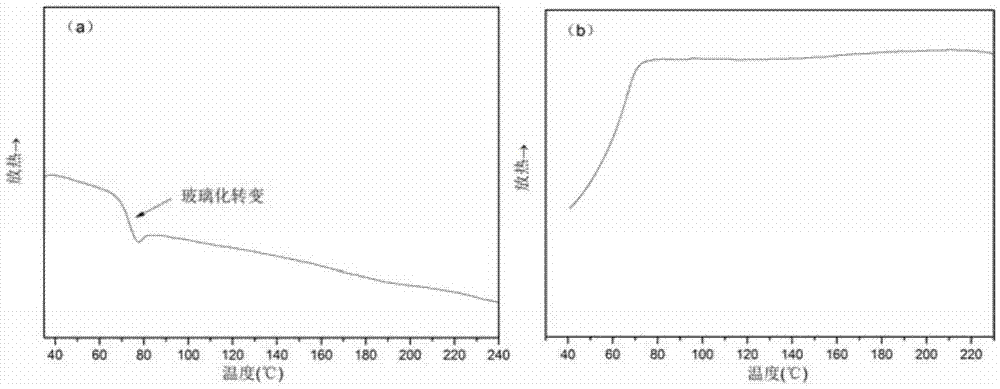Amorphous copolyester and preparation method thereof
A technology of amorphous copolyester, applied in the field of amorphous copolyester and its preparation, can solve the problems of PLA's poor thermal stability, heavy processing odor, narrow processing window, etc., and achieve good dimensional stability of the product, Simple production process and good dimensional stability
- Summary
- Abstract
- Description
- Claims
- Application Information
AI Technical Summary
Problems solved by technology
Method used
Image
Examples
Embodiment 1
[0036] 1.0 moles of terephthalic acid, 1.0 moles of isophthalic acid, 1.1 moles of ethylene glycol, 1.2 moles of 1,4-butanediol and 0.5% (accounting for the total mass of dibasic acid and dibasic alcohol) catalyst tetrabutyl titanate Put it into the three-necked flask, under the protection of nitrogen atmosphere, put it in an oil bath and heat it up: 120°C for 0.5 hours, 160°C for 1 hour, 220°C for 3 hours, until no liquid flows out, and the mixture in the reaction system becomes clear Cool down, add 1% (accounting for the total mass of dibasic acid and dibasic alcohol) catalyst tetrabutyl titanate and 0.01% (accounting for the total mass of dibasic acid and dibasic alcohol) of stabilizer trimethyl phosphate under the protection of nitrogen atmosphere Esters, stir quickly to disperse the catalyst evenly; then vacuumize to 50Pa, polycondense at 250°C for 5 hours until the polymer climbs the pole; discharge to obtain the product.
[0037] The intrinsic viscosity of the copolyest...
Embodiment 2
[0040] Add 1.0 moles of terephthalic acid, 1.0 moles of furandicarboxylic acid, 1.4 moles of ethylene glycol, 1.2 moles of 1,4-butanediol and 1% (accounting for the total mass of dibasic acid and dibasic alcohol) catalyst tetrabutyl titanate In the three-necked flask, under the protection of a nitrogen atmosphere, place it in an oil bath and heat it up: 120°C for 0.5 hours, 160°C for 1 hour, 220°C for 3 hours, until no liquid flows out, and the mixture in the reaction system becomes clear; Lower the temperature, add 1% (accounting for the total mass of dibasic acid and dibasic alcohol) catalyst tetrabutyl titanate and 0.05% (accounting for the total mass of dibasic acid and dibasic alcohol) of stabilizer trimethyl phosphate under the protection of nitrogen atmosphere , stir rapidly to disperse the catalyst evenly; then vacuumize to 50Pa, react at 250°C for 5 hours until the polymer climbs the pole; discharge to obtain the product.
[0041] According to the DSC test, the copoly...
Embodiment 3
[0044] 1.0 moles of terephthalic acid, 1.0 moles of isophthalic acid, 1.5 moles of 1,3-propanediol, 1.5 moles of 1,4-butanediol and 1% (accounting for the total mass of dibasic acid and dibasic alcohol) catalyst tetratitanate Add the butyl ester into the three-necked flask, place it in an oil bath under the protection of nitrogen atmosphere, and heat it up by program: 120°C for 0.5 hours, 160°C for 1 hour, 220°C for 3 hours, until no liquid flows out, and the mixture in the reaction system Become clarified; cool down, add 1% (accounting for the total mass of dibasic acid and dibasic alcohol) catalyst tetrabutyl titanate and 0.05% (accounting for the total mass of dibasic acid and dibasic alcohol) of stabilizer phosphoric acid under the protection of nitrogen atmosphere Trimethyl ester, stir quickly to disperse the catalyst evenly; then vacuumize to 50Pa, react at 280°C for 6 hours until the polymer climbs the pole; discharge to obtain the product.
[0045] According to the DSC...
PUM
| Property | Measurement | Unit |
|---|---|---|
| Vicat softening point | aaaaa | aaaaa |
| Vicat softening point | aaaaa | aaaaa |
| Vicat softening point | aaaaa | aaaaa |
Abstract
Description
Claims
Application Information
 Login to View More
Login to View More - R&D
- Intellectual Property
- Life Sciences
- Materials
- Tech Scout
- Unparalleled Data Quality
- Higher Quality Content
- 60% Fewer Hallucinations
Browse by: Latest US Patents, China's latest patents, Technical Efficacy Thesaurus, Application Domain, Technology Topic, Popular Technical Reports.
© 2025 PatSnap. All rights reserved.Legal|Privacy policy|Modern Slavery Act Transparency Statement|Sitemap|About US| Contact US: help@patsnap.com

